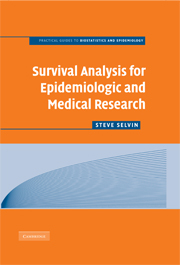Book contents
- Frontmatter
- Contents
- Overview
- 1 Rates and their properties
- 2 Life tables
- 3 Two especially useful estimation tools
- 4 Product-limit estimation
- 5 Exponential survival time probability distribution
- 6 Weibull survival time probability distribution
- 7 Analysis of two-sample survival data
- 8 General hazards model: parametric
- 9 General hazards model: nonparametric
- Examples of R
- Data
- Problem set
- References
- Index
3 - Two especially useful estimation tools
Published online by Cambridge University Press: 03 February 2010
- Frontmatter
- Contents
- Overview
- 1 Rates and their properties
- 2 Life tables
- 3 Two especially useful estimation tools
- 4 Product-limit estimation
- 5 Exponential survival time probability distribution
- 6 Weibull survival time probability distribution
- 7 Analysis of two-sample survival data
- 8 General hazards model: parametric
- 9 General hazards model: nonparametric
- Examples of R
- Data
- Problem set
- References
- Index
Summary
Estimates of parameters based on statistical models and their evaluation are major components of statistical methods. The following outlines two techniques that are key to statistical estimation in general, namely maximum likelihood estimation and the derivation of the statistical properties of analytic functions. These somewhat theoretical topics are not critical to understanding the application of survival analysis methods, but provide valuable insight into the origins of parameter estimates and the variances of their distributions.
Maximum likelihood estimation
Maximum likelihood estimation is used in the vast majority of statistical analyses to determine values for the parameters of models describing the relationships within sampled data. The complexity of this technique lies in the technical application and not its underlying principle. Maximum likelihood estimation is conceptually simple. A small example introduces the fundamental considerations at the heart of the maximum likelihood estimation process.
Suppose that a thumbtack tossed in the air has an unknown probability of landing with the point up (denoted p). Furthermore, three tacks are tossed and one lands point up and the other two land point down. The probability of this result is 3p(1 – p)2. When two values are proposed as an estimate of p, it is not hard to decide the most likely to have produced the observed result (one up and two down) and therefore is the better estimate of the unknown probability p. For the example, the likelihood that one up-tack occurs out of three tossed when p = 0.2 is 3(0.2)(0.8)2 = 0.384 and the probability of the same outcome when p = 0.8 is 3(0.8)(0.2)2 = 0.096.
- Type
- Chapter
- Information
- Survival Analysis for Epidemiologic and Medical Research , pp. 53 - 67Publisher: Cambridge University PressPrint publication year: 2008



